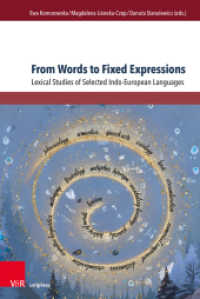- ホーム
- > 洋書
- > 英文書
- > Architecture
Full Description
As the dynamo of South Africa's economy, Johannesburg commands a central position in the nation's imagination, and scholars throughout the world monitor the city as an exemplar of urbanity in the global South. This book offers detailed empirical analyses of changes in the city's physical space, as well as a host of chapters on the character of specific neighbourhoods and the social identities being forged within them. Informing all of these is a consideration of underlying economic, social and political processes shaping the wider Gauteng province. A mix of respected academics, practising urban planners and experienced policymakers offer compelling overviews of the rapid and complex spatial developments that have taken place in Johannesburg since the end of apartheid, along with tantalising glimpses into life on the streets and behind the high walls of this diverse city. The book has three sections. Section A provides an overview of macro spatial trends and the policies that have influenced them. Section B explores the shaping of the city at district and suburban level, revealing the peculiarity of processes in different areas. This analysis elucidates the larger trends, while identifying shifts that are not easily detected at the macro level. Section C is an assembly of chapters and short vignettes that focus on the interweaving of place and identity at a micro level.
With empirical data supported by new data sets including the 2011 Census, the city's Development Planning and Urban Management Department's information system, and Gauteng City-Region Observatory's substantial archive, the book is an essential reference for planning practitioners, urban geographers, sociologists, and social anthropologists, among others.
Contents
Cartography
Section A: The Macro Trends
Chapter 1 Materialities, subjectivities and spatial transformation in Johannesburg - Philip Harrison, Graeme Gotz, Alison Todes and Chris Wray
Chapter 2 The 'thin oil of urbanisation'? Spatial change in Johannesburg and the Gauteng city-region - Graeme Gotz, Chris Wray and Brian Mubiwa
Chapter 4 The impact of policy and strategic spatial planning - Alison Todes
Chapter 9 Public housing in Johannesburg - Sarah Charlton
Section B: Area based Transformations
Chapter 14 The wrong side of the mining belt? Spatial transformations and identities in Johannesburg's southern suburbs - Philip Harrison and Tanya Zack
Chapter 16 Kliptown: Resilience and despair in the face of a hundred years of planning - Hilton Judin, Naomi Roux and Tanya Zack
Section C: Spatial Identities
Chapter 23 Footprints of Islam in Johannesburg - Yasmeen Dinath, Yusuf Patel and Rashid Seedat
Chapter 26 The Central Methodist Church - Christa Kuljian
Chapter 29 Phantoms of the past, spectres of the present: Chinese space in Johannesburg - Philip Harrison, Khangelani Moyo and Yan Yang
Chapter 30 The notice - Caroline Wanjiku Kihato
Chapter 32 Waste pickers/informal recyclers - Sarah Charlton
Contributors
Photographic credits
Acronyms
List of plates
List of figures
List of tables








